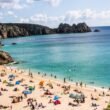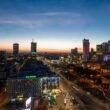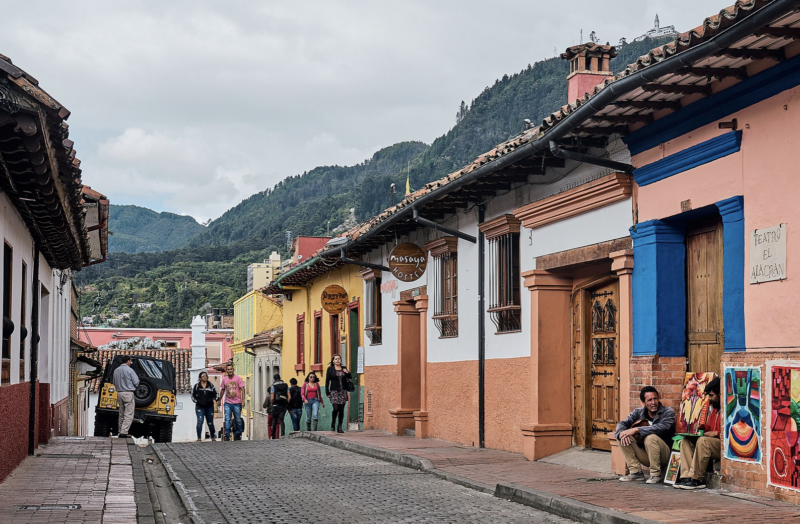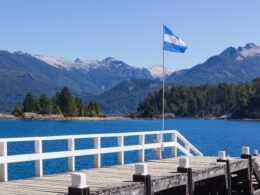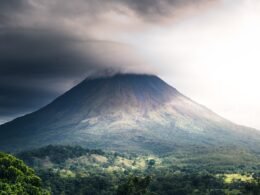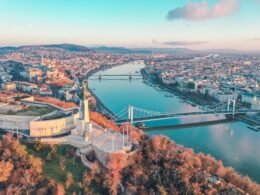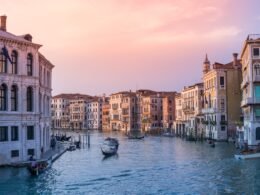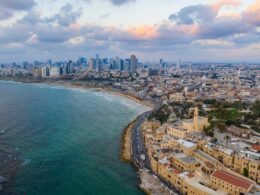The capital of Colombia, Bogotá is a city of immense history, vibrance, and culture. It is the country’s most populated city and has no shortage of restaurants, nightlife, and attractions for tourists. If traveling to Colombia, make sure to visit Bogotá! Here is the best roundup of things to do for 72 hours in Bogotá.
You will be arriving at El Dorado International Airport in Bogotá. To get downtown, you can order an Uber, or Colombia’s popular rideshare service which is similar, called Didi. There are also normal yellow taxis which are parked outside. This will cost you between 20,000-50,000 Colombian pesos ($5-10 USD).
Day 1: Arrive to Bogotá, Plaza de Bolivar, La Séptima
After arriving in Colombia, head to downtown Bogotá to explore some of the city’s old architecture.

Go to Plaza de Bolivar
One of the most recognized plazas in Colombia, Plaza de Bolívar is the plaza that houses the country’s governmental and congressional buildings. Because of this, it is a popular location for events, demonstrations, and celebrations. Make sure to bring your camera, as the main church provides an excellent photo opportunity with the Andes mountains in the background. If you look closely, you can see the church at the top of Monserrate from the plaza, which will be your destination for Day 2 on the itinerary.
The plaza is also home to thousands of pigeons, and there are many vendors who sell dried corn for you to attract them to your hands and arms – making for a great photo! Make sure to also take advantage of the many mobile vendors which walk about the plaza, and you can buy yourself a fresh cup of Colombian coffee or aromatica, a traditional Colombian tea made from fruit.
Walk and shop in La Séptima
Just behind the plaza lies La Séptima, Bogotá’s largest avenue for shopping, restaurants, and souvenirs. Its name originates from the name of the street – Carrera Séptima. Here, you will find endless stores for retail and souvenir shopping. It is also the perfect place to sample authentic Colombian street food, such as buñuelos, empanadas, arepas, chicharron, and almojábana.
La Séptima is also a huge hub for street performers and artisans. Make sure to schedule plenty of time to be able to witness the crazy performances. It is also a great place to buy handmade artisanal jewelry at a reasonable price – most are sold below $5-10.
Where to eat
Where to stay in Bogotá?
- $$$ – W Bogotá
- $$ – ibis Bogotá Museo
- $ – Bendito Hostel
Day 2: Hike Monserrate, explore La Candelaria
Get panoramic views of Bogotá at the top of Monserrate, then explore the cobblestone streets of La Candelaria when you get back down.

Hike to the top of Monserrate
One of Bogotá’s most popular attractions for locals and foreigners alike is Monserrate. It is a hill measuring over 10,000 feet in height, located in downtown Bogotá. The base of the hill is accessible by public transport and foot, and the entrance is completely free. You can summit one of three ways – by foot, tram, or cable car. Going up by foot involves climbing about 1,500 stairs to get to the top, which takes the average person between 1.5-2 hours. On the way up, you will find many food and souvenir vendors, so if you end up getting hungry, you can buy some fresh fruit or a snack.
If hiking is not your jam, the ticket office also offers rides to the top by tram or cable car. The tram is a long train that summits via a railroad track, and the cable car is a transparent cart that can take you up via suspended wires. One-way prices for either vary between 6,000-10,000 pesos (between $2-5 USD depending on the current exchange rate). To save money, you can go up via tram or cable car, and go down by foot.
Once you get to the top, you are rewarded by an expansive plaza with 360° aerial views of the city of Bogotá. There is also a massive church that offers frequent services and an extensive souvenir market. If you are hungry, you can dine at one of the many stall restaurants along the market, where you can have mountainside dining views. You can easily pass half to a full day at Monserrate.
Explore La Candelaria
After you get back down from Monserrate, head over to the surrounding neighborhood of La Candelaria, Bogotá’s colonial sector. Here, you can explore the cobblestone streets with old colonial-style houses dating back to the 17th century. Go shopping at the many local artisanal souvenir shops, or have a bite to eat at one of the street food carts.
Don’t miss Chorro del Quevedo in La Candelaria, a small outlet plaza that is a popular gathering spot for locals. On Saturday nights, you can find street performances, stand-up comedy, and live music as well as local artisans selling handmade crafts.
If you can’t decide which restaurant to eat at in La Candelaria, one must-try is La Puerta Falsa, which translates to “the false door.” It is one of the oldest and most beloved restaurants in Bogotá and Colombia, serving authentic Colombian fare. The restaurant still maintains its customs from 200 years ago, with a maximum seating capacity of 20. If you manage to get a table, make sure to try their most famous dish on the menu, Colombian ajiaco – a soup made with potato, corn on the cob, and chicken.
Where to eat
Day 3: Go museum hopping, try fresh fruit at Paloquemao, lounge in Parque Simón Bolívar
Check out one of the many historical and cultural museums Bogotá has to offer, sample some fresh food, and relax in the city’s largest metropolitan park.

Go to a museum
Since Bogotá is the capital of Colombia, there is a plethora of free or low-priced museums to visit. Make sure to check them out! Here are some of the best history, art, and culture museums to choose from, based on your personal interests:
Museo Nacional (National Museum): Colombia’s national museum. Visit here to learn more about the history of the country, its political past and present, landmark historical moments, and culture. Admission is 4,000 pesos, or a little over $1 USD. If you happen to be visiting during a Colombian national holiday, admission is free.
Museo Botero (Botero Museum): Dedicated to the famous Colombian painter and sculptor, Fernando Botero. His work is recognized internationally for it’s unique style of overly chubby subjects. This museum houses over 200 original pieces of Botero. Admission is free.
Museo de Oro (Gold Museum): One of Bogotá’s most unique museums. This museum houses over 34,000 pieces of gold and attracts over 500,000 tourists annually. It is also the museum with the largest collection of pre-Hispanic gold in the world. Admission is 4,000 pesos (over $1 USD), and is free on Sundays. If you choose to take advantage of the free admission, be prepared for larger crowds.
Museo de Arte Moderno (Museum of Modern Art): For the art buffs, this museum, also known as MAMBO, houses over 1,600 pieces of modern art by Colombian and international artists. General admission is 12,000 pesos, which is about $4-6, depending on the current exchange rate.
Visit Mercado Paloquemao
After soaking up the local museums, treat yourself to a fresh fruit juice or Colombian arepa (fried corn cake filled with cheese) at Mercado Paloquemao. This market is an experience of color, smells, and authentic Colombian culture, since it is a major market where many locals buy their fresh food. Try some of the delicious fresh fruits grown in Colombia, such as guava, uchuva, and lulo. This is also a great place to practice your Spanish when communicating with the vendors (try your hand at some haggling).
Head to Parque Simón Bolívar
To get a break from the city, head over to Parque Metropolitano Simón Bolívar (Simon Bolivar Metropolitan Park), a public park measuring over 400 hectares. Here, you will find several miles of paved cycling and walking trails as well as an artificial lake where you can rent kayaks. Sunday is the park’s busiest time of the week, and it comes to life with people. You will also find carts with street vendors selling fresh fruit and snacks. Make sure to try a cup of salpicón, a popular snack in Colombia that is comprised of a mix of fresh fruits like watermelon, mango, pineapple, and passionfruit in a rich juice.
Where to eat
Useful tips for traveling in Bogotá

The best time to visit Bogotá
Since Colombia is so close to the equator, it has very stable weather all year round. Bogotá, however, is known as the coldest and the rainiest city in Colombia, due to its high altitude in the Andes mountains. It is highly recommendable to bring a rain jacket and umbrella, as you can never predict when it will rain. In general, the driest months which are best to visit Bogotá are between December and March.
What is the currency of Bogotá?
Bogotá uses the national currency of the Colombian peso (COP). Depending on the economy, one US dollar can get you between 2,500-5,000 pesos. The buying power in Colombia is a lot higher than in many American and European cities, so Bogotá is a great destination for the budget traveler.
Can you drink tap water in Bogotá?
Yes. Since Bogotá is a major metropolitan city, all tap water is potable. If you plan on traveling to other cities in Colombia after your stop in Bogotá, make sure to do your research, as not all cities in Colombia have potable water.
The language of Bogotá
The language spoken in Bogotá is Spanish. You will find that locals don’t have high English proficiency in the capital city. In some highly touristic pockets, like La Candelaria, you will have an easier time speaking English. Otherwise, it is highly recommendable to download a translator app or brush up on your Spanish before departing.
Is Bogotá safe?
If you tell your friends or family that you are traveling to Colombia, chances are you will be met with hesitation. This is because Colombia still unfortunately holds a bad reputation in the world due to its violent past. However, the country has undergone a massive transformation in the past decade and now has a booming tourism industry. Colombia is not the country it was 20 years ago, and it is a safe country to travel to.
Overall, Bogotá is a safe city for foreign travelers. However, you will have to keep a moderately high guard when traveling here, as you may run into some bad pockets. Make sure to plan your day from early in the morning, so that you can return to your accommodation before sunset (most petty crime occurs at night). Always keep your valuables on your person at all times, and when possible, wear your backpack in front rather than in the back to percent pickpocketers from accessing your bag.
Final thoughts

For a city of culture, budget-friendly attractions, and delicious food, look no further than Bogotá, Colombia. The capital city packs a punch in its tourism attractions, from museums, to markets, to its colonial center. Colombia has undergone an impressive transformation since the 1980s and 90s, making it a safe destination for tourists.



